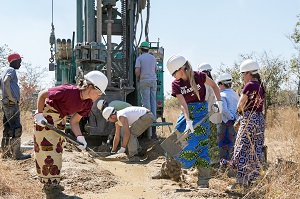Editor’s note: Agri-Pulse and The Chicago Council on Global Affairs are teaming up to host a monthly column to explore how the U.S. agriculture and food sector can maintain its competitive edge and advance food security in an increasingly integrated and dynamic world.
The United States is at a critical public policy crossroads over the issue of maintaining a robust national and international program of agricultural research capable of meeting the demands of the global food security conundrum that faces the planet over the next 35 years.
At the core, the problem confronting the broader community of nations in global food security is a math problem – a math problem that can only be solved by a renewed global commitment to the fundamental challenges of agricultural research, expanded technologies, and innovation.
An additional 2.5 billion people are projected to be taking seats at the world’s dinner table by 2050. Experts estimate that to meet that exponentially increasing demand, global agricultural production must increase by from 50 to 100 percent. Historically, food and agricultural research conducted by the U.S. Department of Agriculture and by the private and quasi-public sectors have been impressive and resulted in a five-fold increase in U.S. production alone between 1910 and 2007. That vital research has produced a global transformation in productivity. The return on investment from U.S. agricultural research has produced an estimated $10 in economic benefit for every $1 invested in research.
The math problem I reference also has a human dimension. If world food production does not grow substantially over coming decades, the number of people living in poverty and chronic hunger will significantly increase. This, in turn, could precipitate rising political instability and possible conflict.
We know that most global population growth will be in developing countries already facing food insecurity. The world is going to need much more food, and it must be produced using our finite land and water resources in the face of uncertainties associated with climate change, among other challenges.
Against that backdrop, consider that China in 2009 overtook the U.S. as the global leader in public spending on agricultural research. Investment in agricultural research is increasing in China, India and Brazil. The U.S. must keep pace unless the gains in productivity over the last century are eroded.
Yet since 2006, U.S. agricultural research spending has declined – along with a telling and critical decline in U.S. agriculture total factor productivity in recent years. Total factor productivity takes into account all of the land, labor, capital, and material resources employed in farm production and compares them with the total amount of crop and livestock output. If total output is growing faster than total inputs, we call this an improvement in total factor productivity and since U.S. agricultural research spending has declined, so has U.S. total factor productivity. That linkage is undeniable.
Mississippi State University has a long and distinguished history of agricultural research achievement and international involvement. Throughout the second half of the 20th century, our Seed Technology Program trained hundreds of individuals from dozens of countries and greatly enhancing food production efforts.
MSU, working with the USDA Agricultural Research Service, led the way in commercializing anhydrous ammonia as a soil‑applied fertilizer back in the 1930s, a development which produced dramatic, game-changing results in improving crop production around the world.
During my tenure as MSU’s president, we’ve developed strong partnerships with the United Nations Food and Agriculture Organization (FAO), the UN World Food Programme (WFP), and the International Fertilizer Development Center (IFDC). Our university works with FAO on food safety and nutrition, aquatic animal health, disease prevention, and diagnostics. MSU is part of a consortium working with the U.S. Agency for International Development (USAID) to boost soybean production across Africa.

Photo by Beth Newman Wynn, MSU Office of Public Affairs
We have only scratched the surface of what research, extension and teaching at academic institutions will be able to contribute to the fight against world hunger in the years ahead, improving the health, safety and security of millions. Our universities have the ability to help, and we actively seek new ways to put our resources to work.
Research universities have knowledge, infrastructure, and experience pertinent to every aspect of the food chain, from the laboratory to the farm to the market to the table. Our challenge is to bring our resources to bear on these and other critical global issues.
-30-
ABOUT THE AUTHOR: Mark E. Keenum, a former Under Secretary of the U.S. Department of Agriculture, is the 19th president of Mississippi State University. Keenum has also been appointed vice chairman of the Foundation for Food and Agricultural Research by U.S. Secretary of Agriculture Thomas Vilsack and is a member of the Advisory Group for the Chicago Council’s Global Agricultural Development Initiative.